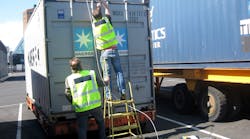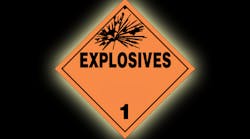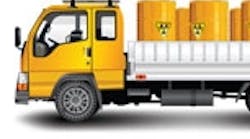Research in Germany and the Netherlands found hazardous levels of gases and vapors in around 20% of all freight containers. This represents a hazard to staff responsible for inspecting, stuffing or destuffing these containers.
It is therefore necessary to examine containers before entry. This is usually done using gas detection techniques that help assess the substances of greatest concern.
Chemical Hazards
There are two potential sources of hazardous chemicals inside cargo containers: fumigants and chemicals that arise from the goods or packing materials.
Fumigants are applied to goods to control pests and micro-organisms. Cargoes most likely to have been fumigated include foodstuffs, leather goods, handicrafts, textiles, timber or cane furniture, luxury vehicles and cargo in timber cases or on timber pallets from Asia.
According to the IMO's international regulations, “Recommendations on the safe use of pesticides in ships,” fumigated containers and ship cargoes must be labelled, giving specifications about dates of fumigation and the fumigation gas used. Furthermore, appropriate certificates are necessary and these records have to be forwarded to the Port Health Authorities without their explicitly asking for them.
Absence of marking cannot be taken to mean fumigants are not present. Containers marked as having been ventilated after fumigation may also contain fumigant that was absorbed by the cargo and released during transit. There is also concern that fumigants may be retained in the goods and subsequently present a hazard to logistics providers, retail staff and consumers.
Common fumigants include Chloropicrine, Methyl bromide, Ethylene dibromide, Sulfuryl fluoride and Phospine.
“While the fumigants are highly toxic, the number of containers exceeding occupational exposure limits (OEL) due to other chemicals is much greater and the number of ‘failed’ containers is likely to rise as more containers are tested, detection methods improve and new gases are identified,” says Peter Broersma, with Reakti, a Dutch firm of health and safety consultants.
Gas Sources
Containers often travel for extended periods and experience a wide range of temperatures. It is therefore not surprising that unsafe levels of gases should accumulate in the confined space of a container. Broersma identifies the typical sources of gases over their OELs as follows:
∙ Solvents from glues used to produce clothing, accessories and shoes;
∙ 1,2, dichloroethane from plastic products, PVC, blister packaging etc.;
∙ Formaldehyde found in cheap furniture (plywood, MDF etc.) but also in used pallets and lashing materials;
∙ Solvents and formaldehyde from poly-resin products;
∙ Carbon monoxide from charcoal and natural products;
∙ Carbon dioxide from natural products;
∙ Ethylene oxide from medical equipment sterilized with ethylene oxide;
∙ Solvents including Benzene, Toluene, Ethylbenzene and Xylene (BTEX) in Christmas and decoration products;
∙ Flammable gases from disposable lighters;
∙ Ammonia in household equipment with Bakelite parts;
∙ Volatile Organic Compounds (VOCs) from fire blocks
∙ Pentanes and hexanes from consumer electronics;
∙ Phosphine/arsine from natural minerals such as ferrosilicon.
Inspection procedures
Major ports have strict regulations in place to protect against potential hazards in cargo containers. In general, every incoming stream of products has to be checked for dangerous gases and if one or more gases are detected during the preliminary investigation, all of the containers from this specific producer must be checked. If no gases are detected, it may be possible to only conduct random tests a few times per year. If it is necessary for Customs staff to enter a container, all containers must first be tested and if necessary de-gassed.
Since there are a large number of gases that might be present inside a container, the traditional approach to monitoring has been either to employ a wide range of instruments or to use chemical stain tubes for the most common gases, or a combination of both.
∙ Chemical stain tubes provide a colorimetric assessment of an individual gas, typically with an accuracy of +/- 15%. Different tubes are available for many gases and results can be obtained between 5 seconds and 15 minutes depending on the test. Once a result has been obtained, the tube itself is hazardous waste and must be disposed of. Historically stain tubes have been popular because the cost per test is low.
∙ Instrumental gas analyzers such as electrochemical sensors that measure either a single gas or a small number of gases impart a level of risk similar to stain tubes because of the possibility of missing or failing to measure a harmful gas. Deploying multiple instruments means each will require maintenance and re-calibration in addition to a power source or re-charging.
∙ A preliminary assessment can be performed with a PID gas detector to measure total VOCs; an LEL combustible gas sensor and handheld electrochemical sensors might be employed for toxic gases such as carbon monoxide, phosphine, ammonia and ethylene oxide. An FTIR (Fourier Transform Infra Red) analyzer could then be employed to measure 50 target gases simultaneously in a test that would take approximately 3 minutes. While a PID gas detector measures total VOCs, it does not provide an individual value for, say, benzene, which is a known carcinogen.
One of the potential problems with electrochemical sensors is their inability to cope with high concentrations in a sample gas. This can result in poisoning of the cell, which would normally result in instrument failure. In contrast, similar high concentrations do not harm FTIR, and the instrument can recommence analysis after a few minutes of backflushing.
“The problems of hazardous gases in cargo containers is now widely publicized and the requirement for testing is growing as employers fulfil their responsibility to protect the health and welfare of staff,” says Broersma. “FTIR has long been established as an accurate technology for the simultaneous measurement of gaseous emissions from industrial processes, so when the Finnish company Gasmet developed a portable version we were very eager to investigate its feasibility in container testing. We are now able to test for all of these gases in around three minutes, which dramatically lowers the time taken for container inspection and greatly increases the number of containers that can be examined every day.”
This technology is now used at Rotterdam, Amsterdam, Vlissingen, Antwerp and Hamburg, and a company providing ship fumigation and degassing is using portable FTIR all over the world.”
While FTIR is able to analyze multiple gases, the technique is not suitable for inert gases, homonuclear diatomic gases (e.g., N2, Cl2, H2, F2, etc) or H2S (detection limit too high).





